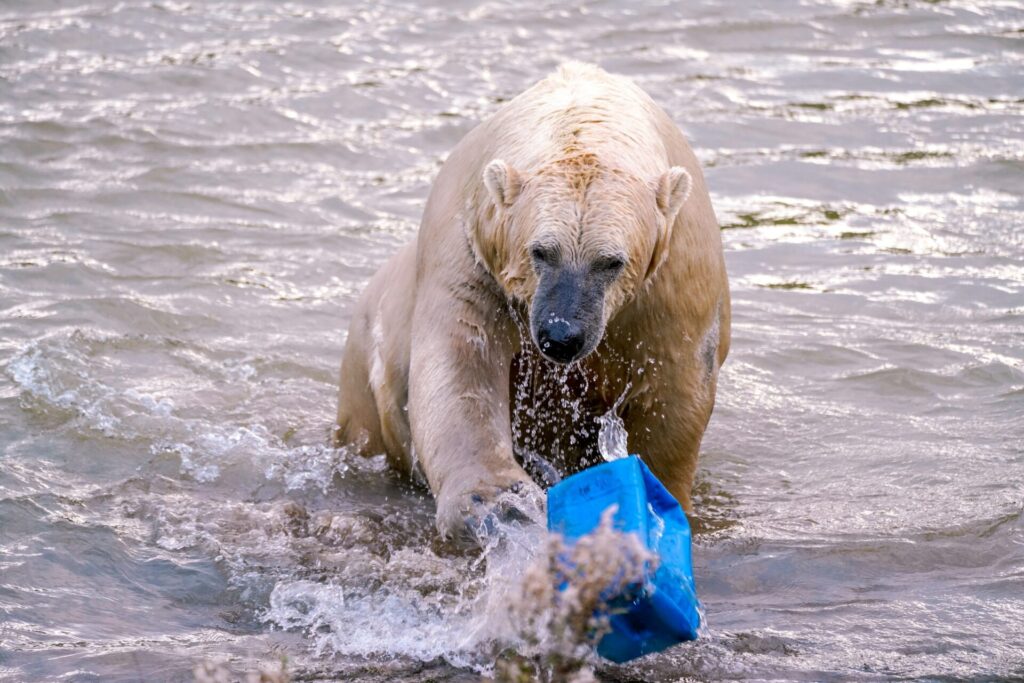The heat is on: Earth Day 2024 puts spotlight on plastics
By Jessica McKenzie | April 22, 2024
 Photo by Yomex Owo on Unsplash
Photo by Yomex Owo on Unsplash
In honor of Earth Day, the Bulletin of the Atomic Scientists thought it worth taking the pulse of the current climate and environmental crises facing the planet, and what is being done about them. Below is a roundup on the “State of the Earth,” if you will.
One word: Plastics. The first Earth Day in 1970 was organized in response to a catastrophic oil blow-out off the coast of California the year before, when up to 100,000 barrels of oil spilled into the Santa Barbara Channel. The disaster killed some 3,500 sea birds, as well as marine mammals like dolphins, elephant seals, and sea lions. At the time, it was the largest oil spill in United States waters, although it was later surpassed by the 1989 Exxon Valdez spill and the 2010 Deepwater Horizon disaster.
This year, the organization behind Earth Day has set their sights on a more diffuse, global environmental disaster: plastics.
The plastics industry is expected to double or triple production by 2050, unless global leaders intervene. Even if the rate of plastic production holds steady, the emissions from the plastic sector could account for a fifth of the remaining carbon budget by mid-century, according to a new analysis from Lawrence Berkeley National Laboratory.
Even present-day levels of plastic manufacturing generate a shocking amount of greenhouse gas emissions. According to The Guardian, “Plastic creation generated 2.24 gigatonnes of planet-heating pollution in 2019, or as much as 600 coal-fired power plants.”
Consequently, Earth Day organizers are calling for a 60-percent reduction in plastics production by 2040, and a phase-out of single-use plastic by 2030. It’s a timely demand, as nearly 200 UN member states have begun negotiating a plastics treaty. The intergovernmental Negotiating Committee will meet for a fourth session in Canada this week to continue discussions.
“All this plastic was produced by a petrochemical industry with an abysmal record of toxic emissions, spills, and explosions,” said Denis Hayes, chair emeritus of EarthDay.org. “Plastics are produced in polluting facilities that somehow seem to always be located in the poorest neighborhoods. Some plastics are lethal when combusted; other plastics transmit hormone-disrupting chemicals; and all plastics can starve birds and suffocate sea life. At every stage of their life cycles, from the oil well to the town dump, plastics are a dangerous blight.”
The heat is on. March 2024 was the 10th consecutive month to break global heat records. The average surface air temperature was 14.14 degrees Celsius, 0.73 degrees above the 1991-2020 average for the month and 0.10 degrees hotter than the previous high set in March 2016. What’s more, the global average temperature over the past 12 months (April 2023 – March 2024) was the highest on record, 0.70 degrees Celsius warmer than the 1991-2020 average and 1.58 degrees above the 1850-1900 pre-industrial average. In other words, in the past 12 months, the Earth has already exceeded the warming limit of 1.5 degrees set in the 2015 Paris climate agreement.
Oceans in crisis. The average global sea surface temperature in March was also the highest monthly temperature on record, 21.07 degrees Celsius, or nearly 70 degrees Fahrenheit. Scientists said this month that coral reefs around the globe are undergoing another mass bleaching event because of the warming oceans. Bleaching has been confirmed in over 50 countries or territories. Coral bleaching occurs when stressed corals expel their primary food source: the algae that gives them their vibrant color. “As the world’s oceans continue to warm, coral bleaching is becoming more frequent and severe,” said Derek Manzello, NOAA Coral Reef Watch coordinator, in a statement to the press.
Biodiversity in decline. The Intergovernmental Platform on Biodiversity and Ecosystem Services estimates that one million plant and animal species are at risk of extinction, and that the extinction loss is accelerating due to climate change and habitat destruction through deforestation or other land-use changes. One way to measure this crisis is by analyzing recordings taken from different habitats. One study of 200,000 sites in North America and Europe found “pervasive loss of acoustic diversity and intensity of soundscapes across both continents over the past 25 years, driven by changes in species richness and abundance.” The threats to species will increase with every degree of warming: at 1.5 degrees Celsius (2.7 degrees Fahrenheit), 4 percent of mammals will lose half their habitat; at 3 degrees of warming (more than 5 degrees Fahrenheit), more than 40 percent of mammals will lose half of their habitat.
Planetary tipping points. The Intergovernmental Panel on Climate Change defines tipping points as “critical thresholds in a system that, when exceeded, can lead to a significant change in the state of the system, often with an understanding that the change is irreversible.” Whether the Earth has passed those tipping points, or is close to passing them, is a controversial subject of debate. The Global Tipping Points report released late last year asserted that the Earth is teetering on the edge of five key thresholds, including the collapse of the Greenland ice sheet, widespread permafrost thawing, widespread death of warm water corals, and the collapse of an important oceanic current in the North Atlantic. Even if the possibility of crossing some or all of these tipping points is currently slim, “it is precisely those high-end possibilities of system collapse, rather than the middle-of-the-road linear probabilities, that must be the focus of concern and should spur the world to action,” as David Spratt wrote in the Bulletin last year.
As dire as the above all sounds, it’s worth acknowledging and celebrating some of the more positive signs of climate and environmental action around the globe.
Climate wins in court. Earlier this month, a group of 2,000 Swiss women won a lawsuit against their government for violating the human rights of its citizens by not doing enough to combat climate change— an important, precedent-setting decision. The president of Europe’s highest human rights court said the Swiss government had failed to meet its own targets for slashing emissions and had not set a national carbon budget. And last summer, a Montana judge ruled in favor of a group of young plaintiffs and said the state’s failure to consider climate change impacts in environmental reviews was an unconstitutional violation of Montana’s constitution, which states “[t]he state and each person shall maintain and improve a clean and healthful environment in Montana for present and future generations.” Germany was compelled to increase its emissions-reduction target to a 65 percent cut by 2030 after a group of young environmental activists won a case that said the previous target was insufficient to limit warming to “well below 2 degrees Celsius,” as set forth in the Paris climate agreement. Since 1986, over 2,340 climate change cases have been filed in courts worldwide.
Renewables ascendant. This month, Mark Z. Jacobson, the director of Stanford University’s Atmosphere/Energy program, celebrated the fact that renewable sources had met 100 percent of California’s energy demands for 25 of the past 32 days. Meanwhile, a community solar developer called Nexamp recently raised over $500 million to build solar arrays around the United States. These projects allow people who can’t install rooftop solar to buy into these larger projects and receive credits on their energy bills.
Nature-based policies. Government policies that take aim at reducing deforestation and other types of environmental degradation doubled over the last 12 months, according to a new study. The European Union, for example, will require companies to prove that the products they import, including cocoa, coffee, rubber, palm oil, soy, beef, and wood, are not tied to recent deforestation or forest degradation.
Now it’s your turn: What climate and environmental news do you think is important to share or celebrate this Earth Day? Sound off in the reader comments below.
Together, we make the world safer.
The Bulletin elevates expert voices above the noise. But as an independent nonprofit organization, our operations depend on the support of readers like you. Help us continue to deliver quality journalism that holds leaders accountable. Your support of our work at any level is important. In return, we promise our coverage will be understandable, influential, vigilant, solution-oriented, and fair-minded. Together we can make a difference.
Keywords: Earth Day, biodiversity, global warming, ocean warming, renewables, tipping points
Topics: Climate Change














